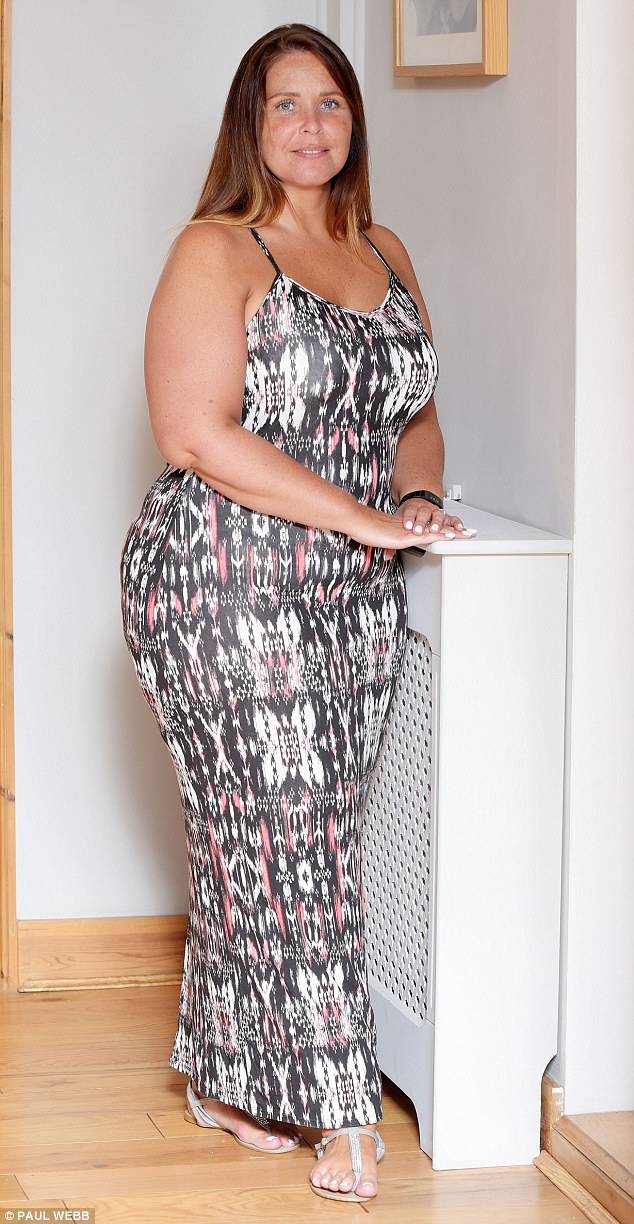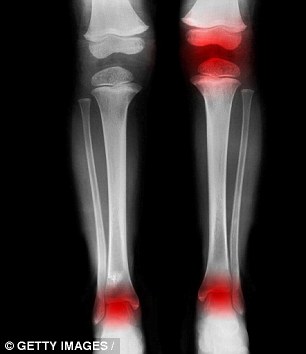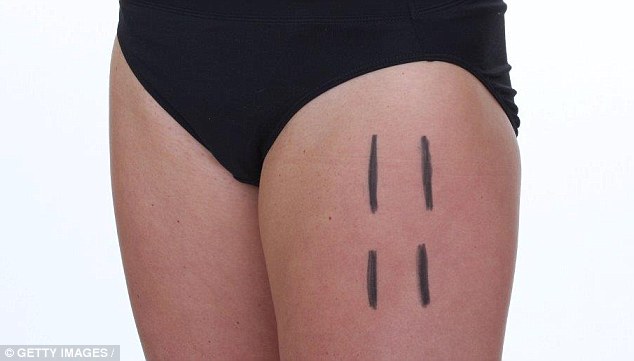The medical condition that leaves women with ever bigger legs, even when they diet
Hitting puberty, what troubled Laura Childs was not her skin, but her legs, which began to balloon completely out of proportion with the rest of her body.
‘It was much more exaggerated than just being pear-shaped,’ recalls Laura, 37, a local authority administrative officer, who lives in Dover with her husband, Dean, 42, a trainee teacher, and their two children Leah, 13, and Oliver, ten.
‘I’d previously been very slim, but over two to three years my legs became much bigger than my top half, up to two dress sizes bigger.
‘It was weird because I had slim ankles and feet — the fat formed a cuff above the knee and the ankle.

Hitting puberty, what troubled Laura Childs was not her skin, but her legs, which began to balloon completely out of proportion with the rest of her body
The skin on my legs would bruise really easily, too, even if I just scratched an itch my whole leg would bruise.
My legs also swelled up in the heat and could be quite achy and painful.
‘I couldn’t understand it because I wasn’t eating any more than usual. I dreaded having to wear shorts for PE lessons and I would cover my legs up as much as I could with long skirts and wide-legged trousers,’ recalls Laura.
Her elder sister, Emma, and their mother, Janice, had exactly the same leg-shape.
‘We just thought it was our family body shape and we had to live with it. We all tried dieting but could only lose weight from our top halves.’
When Laura was pregnant with Leah, her legs — particularly her calves — got even larger and more painful.
-
 Is the cure for baldness in sight? Four-month treatment…
Is the cure for baldness in sight? Four-month treatment… Why morning sickness isn’t so bad after all: Nausea while…
Why morning sickness isn’t so bad after all: Nausea while… New test could diagnose urinary infection within HOURS:…
New test could diagnose urinary infection within HOURS:… Teenager whose mother believed his headaches were from…
Teenager whose mother believed his headaches were from…
‘After Leah was born, my GP prescribed me pills for water retention, but they did nothing.’
Laura only discovered the real cause after sister Emma lost three stone, but none from her legs — that’s when her doctor diagnosed Emma and then Laura with lipoedema.
This is a common condition that affects only women and which causes abnormal amounts of fat to accumulate on the lower body (the legs, buttocks and hips although it sometimes also affects the arms).
The feet and hands are not affected so the excess fat forms a distinctive ‘bracelet’ effect with fat overhanging the ankle or the elbow or wrist.
It is a painful, often disabling, condition though to affect up to one in ten women.

Laura only discovered the real cause after sister Emma lost three stone, but none from her legs — that’s when her doctor diagnosed Emma and then Laura with lipoedema
While the cause is not clear, it’s likely to be linked to hormones; the fat accumulation starts in most cases after puberty or other times of hormonal upheaval such as pregnancy or the menopause and generally becomes progressively worse over time, causing increased pain and mobility problems.
‘Women affected can lose weight only from their upper bodies — it’s not known why the fat does not respond to dieting.
‘As the condition tends to run in families experts believe it has a genetic element, although some women don’t have a family history.
‘The classic hallmarks of lipoedema are that the lower limbs are enlarged and the fat that accumulates there is painful — we don’t really know why,’ explains Vasu Karri, a plastic surgeon who runs a private clinic in Hull where he treats the condition.
‘Patients will often say to me they feel like they’re wearing a fat suit from the waist down.

Lipoedema affects up to one in ten women, and puts a lot of pressure on their joints
‘Some women are acutely sensitive to any type of pressure on their legs and can’t even stand a duvet over them as it’s so painful.
‘As the disease progresses, these women may have difficulties walking because their because of pressure on joints from the weight and may even need joint replacements.
Despite the number of those affected, the condition is poorly recognised.
A survey in 2014 by the charity Lipoedema UK found the average age of diagnosis was 44, although 46 per cent of respondents said their symptoms started at puberty and only 5 per cent were diagnosed by their GP — patients are usually told they are just fat or lying about what they eat.
The main treatments available on the NHS currently are compression tights to reduce fluid build-up which sometimes accompanies lipoedema, and manual lymphatic massage, a specialised type of massage which helps drain fluid out of affected areas.
However, neither treatment can reduce the fat, as Laura and Emma discovered.
‘At first we were both relieved that there was a medical cause for our fat legs, but when we realised the treatments options were very limited that quickly wore off,’ says Laura.
‘I found the NHS compression tights too uncomfortable to wear and the manual lymphatic massage only reduced the swelling, not the fat.’
The only other treatment for lipoedema is a form of liposuction known as tumescent liposuction, a specialised technique which must be carried out by surgeons with specialist knowledge about the lymphatic system so it is not damaged.

Laura Childs has been told she needs four to five liposuction operations at a cost of £32,000, and says: ‘I just don’t know how we would find the money for this’
However, the treatment is expensive and many local health authorities refuse to fund it, arguing that lipoedema is purely a cosmetic problem and/or that liposuction is not proven to work for the condition.
And yet in other countries, including Germany, the treatment is routinely offered for the treatment of lipoedema.
Furthermore, research published last year in the British Journal of Dermatology showed it was effective; doctors at the University of Luebeck followed up lipoedema patients up to eight years after they were treated with liposuction and found that the effects had lasted.
‘Liposuction is a permanent solution for lipoedema provided all the abnormal fat cells are removed, research shows that it recurs in only 2 per cent of cases,’ says Anne Dancey, a plastic surgeon at Spire Park Way Clinic in Birmingham who uses the technique.
But Sharie Fetzer, chair of Lipoedema UK, says women who apply for treatment with liposuction on the NHS face a struggle to get funding.
‘These women have usually spent their lives hiding away, some have been told by their doctors and even friends and family that they must be lying about what they eat or the amount of exercise they do — then when they eventually get a diagnosis, they are denied the treatment they need.’
It’s often wrongly assumed that these women are overeating and lazy, adds Ms Dancey. ‘Often they’ll get stared at in public and people will make horrible remarks.
‘This is frustrating and upsetting because lipoedema is a recognised medical condition which causes pain and mobility problems.
She says the National Institute for Healthcare and Excellence (NICE) hasn’t looked at liposuction AS a treatment for lipoedema because it’s not seen as a priority.
‘Consequently some women will even remortgage their homes because they are so desperate to get the fat removed.

Sharie Fetzer, chair of Lipoedema UK, says women who apply for treatment with liposuction on the NHS face a struggle to get funding (stock image)
‘In most cases it’s the pain and the fear of their immobility getting worse or needing a joint replacement that drives them to this and not what their legs look like though.
Susan Acton, 64, a retired nursery nurse from Forton, near Lancaster, was diagnosed with lipoedema three years ago despite having symptoms since her 20s.
Susan, who is married to Ian, 68, a semi-retired joiner, has already been turned down for NHS funding and is now considering travelling to Germany and paying for the treatment — at a cost of £20,000 — with their retirement savings.
‘It’s the pain and lack of mobility I find hardest to deal with,’ she says.
‘I can cover up my big legs with wide trousers and long tops, but the pain is something else. It’s becoming unbearable. I really don’t want to end up in a wheelchair because my legs have got so big I can’t walk.’
Laura Childs has applied for NHS funding for liposuction, but isn’t hopeful. She’s been to see a private consultant, but has been told she needs four to five liposuction operations at a cost of £32,000 — ‘I just don’t know how we would find the money for this.
‘I feel it’s very wrong we’re being denied NHS treatment and told it’s just cosmetic when lipoedema is a real medical problem.
‘Now my daughter is starting with the same symptoms as me and I’m really worried that she will have to face the same battle to get treatment.’

The only surgical treatment for lipoedema is a form of liposuction known as tumescent liposuction, a specialised technique
Dr Vaughan Keeley, a consultant at the Royal Derby Hospital who treats the condition, says part of the problem is that while it is an accepted medical condition, lipoedema is not yet officially recognised in the World Health Organisation’s International Classification of Diseases.
There is also no good diagnostic test — ‘we do sometimes use ultrasound for confirming it but that’s not a proven test as yet’.
Diagnosis is via clinical assessment and sometimes it’s not easy to distinguish lipoedema, especially in women who are also overweight, he says.
However one of the key characteristics is an inability to lose weight from the legs even after successfully dieting and losing weight elsewhere in the body.
Other signs include easy bruising (even from just scratching or patients wake up with bruises not knowing what has caused them) and painful fat.
‘But until we get a diagnostic test or set of diagnostic criteria that are universally agreed it’s going to be difficult to persuade a body like NICE to look at this.’
lipoedema.co.uk